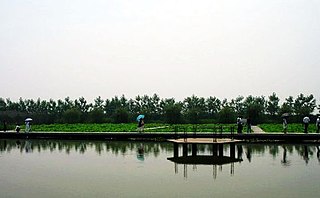
Huai'an,formerly Huaiyin,is a prefecture-level city in central Jiangsu Province in Eastern China. As of 2020,the built-up area (metro) of its 3 central urban districts had 2,544,767 inhabitants and the prefecture-level city as a whole had 4,556,230 inhabitants,down from 4.8 million in 2010.

Suqian is a prefecture-level city in northern Jiangsu Province,China. It borders Xuzhou to the northwest,Lianyungang to the northeast,Huai'an to the south,and the province of Anhui to the west.

Hongze Lake,previously known as Lake Hungtze or Hung-tse,is the fifth-largest freshwater lake in China. Although it is known to have existed from antiquity,it drastically increased in size during the Qing when the Yellow River—then still flowing south of Shandong—merged with the Huai. The increased sediment and flow combined to greatly expand the lake,swallowing the previous regional center of Sizhou and the Ming Zuling tombs. During the imperial and republican periods,the lake formed part of the border between Jiangsu and Anhui provinces but since 1955 the previous borders have been shifted to place it entirely under Jiangsu's administration. It is now encompassed by the counties of Sihong and Siyang in Suqian Prefecture and Xuyi and Hongze in Huai'an Prefecture. Since the establishment of the People's Republic of China,the lake has generally decreased in size as more of its inflow has been diverted for irrigation.

Suining County is under the administration of Xuzhou,Jiangsu province,China;it is the southernmost county-level division of Xuzhou and borders the prefecture-level cities of Suqian to the east and Suzhou of Anhui to the south and west.
The Si River is a river in Shandong Province,China. It also ran through the area of modern Jiangsu Province until floods in 1194.

Xuyi is a county under the administration of Huai'an Prefecture in central Jiangsu Province in eastern China. The southernmost of Huai'an's county-level divisions,it borders the prefecture-level cities of Suqian,Jiangsu,to the north and Chuzhou,Anhui,to the south and west. Xuyi is the site of the Ming Zuling tombs and also noted for production of crayfish.
Lianshui County is under the administration of Huai'an,Jiangsu province,China. The northernmost county-level division of Huai'an,it borders the prefecture-level cities of Lianyungang to the north,Yancheng to the east,and Suqian to the west.

Si County or Sixian is a county in northeast Anhui Province,China. It borders the northern part of Jiangsu Province to the north and east and is under the administration of the prefecture-level city of Suzhou.

Xinyi is a county-level city under the administration of Xuzhou,Jiangsu province,China. It borders the prefecture-level cities of Linyi (Shandong) to the north,Lianyungang to the northeast,and Suqian to the east and south.

Shuyang is a county in northern Jiangsu province. It is under the administration of the prefecture-level city of Suqian. Shuyang sits on the Northern Jiangsu Plains and borders the cities of Xuzhou,Lianyungang,and Huai'an to the north,east,and south.

Siyang County is under the administration of Suqian,Jiangsu province,China. It borders the prefecture-level city of Huai'an to the southeast.

Sihong County is under the administration of Suqian,Jiangsu province,China. It borders the prefecture-level cities of Huai'an to the southeast,Chuzhou (Anhui) to the south,Bengbu (Anhui) to the west,and Suzhou (Anhui) to the northwest.
Pang Xun (龐勛) was the leader of a major rebellion,by soldiers from Xu Prefecture,against the rule of Emperor Yizong of the Chinese Tang Dynasty,from 868 to 869. He was eventually defeated by the Tang general Kang Chengxun,who was assisted by the Shatuo general Zhuye Chixin.
Shi Pu (時溥),formally the Prince of Julu (鉅鹿王),was a warlord of the late Tang dynasty,who controlled Ganhua Circuit as its military governor (Jiedushi). He was eventually defeated by Zhu Quanzhong's general Pang Shigu (龐師古),and committed suicide with his family.

The Ming Ancestors Mausoleum,Ming Ancestor Tomb,or Zuling Tomb was the first imperial mausoleum complex of the Ming dynasty,constructed at a geomantically advantageous site near the inlet of the Huai River into the west side of Hongze Lake in present-day Xuyi County,Huai'an Prefecture,Jiangsu Province,China. Built between 1386 and 1413 by Zhu Yuanzhang—the Hongwu Emperor who founded the Ming—and his son Zhu Di the Yongle Emperor to display their filial piety,it was located north of the town of Sizhou,where the ancestors of the dynasty had lived. The remains of the Hongwu Emperor's grandfather Zhu Chuyi are known to have been disintered and moved to the site. He,his father Zhu Sijiu,and his grandfather Zhu Bailiu were posthumously revered at the site as honorary emperors,Zhu Chuyi as the Xi Ancestor of the Ming (Xizu),Zhu Sijiu as the Yi Ancestor of the Ming (Yizu),and Zhu Bailiu as the De Ancestor of the Ming (Dezu).
Yangzhou,Yangchow or Yang Province was one of the Nine Provinces of ancient China mentioned in historical texts such as the Tribute of Yu,Erya and Rites of Zhou.
Xuzhou as a historical toponym refers to varied area in different eras.
Chuzhou or Chu Prefecture (楚州) was a zhou (prefecture) in imperial China seated in modern Huai'an,Jiangsu,China. It existed (intermittently) from 581 to 1228.
Haizhou or Hai Prefecture (海州) was a zhou (prefecture) in imperial China seated in modern Lianyungang,Jiangsu,China. It existed (intermittently) from 549 to 1912.

Jiangnan,formerly romanized as Kiangnan,was a historical province of the early Qing dynasty of China. Its capital was Jiangning,from which it is sometimes known as Nanjing or Nanking Province. Established in 1645 during the Qing conquest of Ming,it administered the area of the earlier Ming province of Nanzhili,reaching from north of the Huai River—at the time the course of the Yellow River—to south of the Yangtze River in East China. Its territory was later divided into the separate provinces of Jiangsu and Anhui during the reign of the Qianlong Emperor (1736–1795),although the exact timing is disputed. Under the Republic and People's Republic of China,an area of Jiangsu also became the provincial-level municipality of Shanghai.













